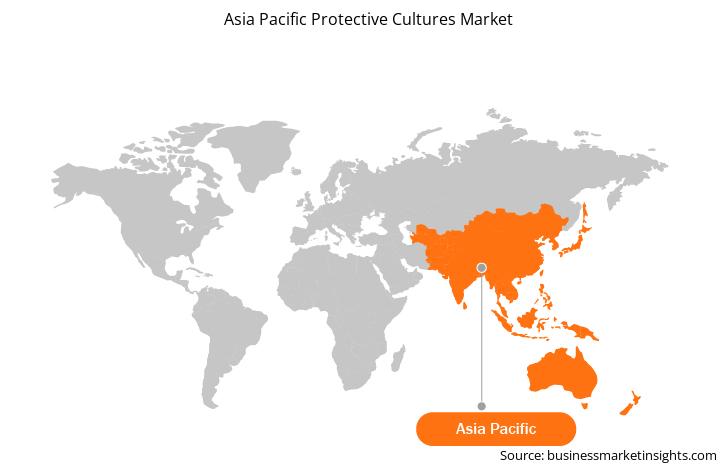亚太地区保护性菌种市场预测至 2028 年 - COVID-19 影响及目标微生物(细菌、酵母和霉菌)和应用(食品加工和动物饲料)的区域分析
No. of Pages: 83 | Report Code: TIPRE00025726 | Category: Food and Beverages
No. of Pages: 83 | Report Code: TIPRE00025726 | Category: Food and Beverages
亚太地区的保护性菌种市场分为澳大利亚、中国、印度、日本、韩国和亚太地区其他地区。中国是最重要的乳制品市场,主要由乳制品消费的增长推动。对天然零食、酸奶等发酵乳制品和酸奶等乳制品的需求不断增长,加上产品和包装创新,正在推动亚太地区乳制品市场的增长。因此,由于乳制品消费量的增加以及保护性培养物的好处(例如抑制病原微生物和腐败微生物生长的能力),预计未来几年保护性培养物市场将出现显着增长。此外,亚洲人口对天然和清洁标签产品的认识不断提高,也有助于市场扩张。随着亚太地区乳制品消费量的不断增长,对产品标签中成分天然且成分列表简短的可持续乳制品的需求量很大。这一因素将在未来几年推动该地区保护性文化市场的增长。保护性培养物,通常称为细菌培养物,用于乳制品和肉类中以延长其保质期。这些食品的保质期短已成为食品和消费者关注的主要问题。饮料行业。保护性文化的使用有助于克服这些担忧,从而推动该地区的市场增长。此外,由于消费者生活方式和饮食习惯的变化,对加工和包装食品的需求不断增加。保护性文化有助于延长便利产品的保质期。因此,保护性文化市场预计在预测期内将显着增长。此外,宠物食品和动物饲料制造商对增强食品或饲料适口性、保持新鲜度和减少霉菌生长等问题持谨慎态度。保护性培养物用于宠物食品和动物饲料中,以防止霉菌和真菌的形成,并提高产品的适口性和新鲜度。此外,亚太地区消费者对清洁标签宠物食品和动物饲料的偏好不断提高,预计将在预测期内为该地区的保护性培养物市场创造利润丰厚的机会。
<亚洲经济体受到 COVID-19 大流行的严重打击。印度的病例数最高,印度、泰国和其他亚洲经济体出现新一波的 COVID-19 疫情,延长了疫情对食品和食品的影响。饮料行业。亚太地区各个经济体的政府正在采取可能的措施来限制病毒的传播,这直接影响了工业部门的增长,进而对保护性文化市场的增长产生了负面影响。
亚太地区保护性菌种市场预计到 2021 年将从 3804 万美元增长到 2028 年达到 7621 万美元;预计 2021 年至 2028 年复合年增长率为 10.4%。据世界野生动物基金会称,随着到 2050 年全球人口预计将达到 90 亿,可持续性和食物浪费正在影响食品行业。食品生产商在行动时考虑到可持续性至关重要。报告表明,发达国家生产的牛奶和其他乳制品中有超过10%~20%被浪费或损失,其中约一半的浪费是消费者在购买后由于保质期限制或微生物腐败等因素造成的。最近的研究证实,产品保质期仍然是消费者购买的一个重要条件。因此,生产商必须考虑产品的开放保质期,以支持可持续供应链并减少对食物浪费负担的影响。每年有13亿吨食物被浪费。在工业化国家,超过 40% 的损失发生在零售和消费者层面。研究表明,仅延长一天的保质期就可以减少每年多达 20 万吨的家庭食物浪费。因此,延长保质期可以减少食品浪费并有助于建立一个更加可持续的世界,这将促进预测期内保护性培养物市场的增长。这促进了保护性菌种市场的增长。
基于在目标微生物方面,亚太地区的保护性培养物市场分为细菌、酵母菌和微生物。模具。 2020 年,酵母和酵母模具细分市场占据亚太地区保护性文化市场的最大份额。根据应用市场分为食品加工和动物饲料。食品加工领域在 2020 年占据最大的市场份额。同样,根据食品加工,市场分为乳制品
一些主要的一级和二级市场准备本亚太地区保护性培养物市场报告时参考的来源包括公司网站、年度报告、财务报告、国家政府文件和统计数据库等。报告中列出的主要公司包括 Bioprox、Chr. Hansen Holding A/S、DSM、Lallemand Inc.、International Flavors & Co. Fragrances Inc.、Kerry Group 和 Sacco System 等。
Strategic insights for Asia Pacific Protective Cultures involve closely monitoring industry trends, consumer behaviours, and competitor actions to identify opportunities for growth. By leveraging data analytics, businesses can anticipate market shifts and make informed decisions that align with evolving customer needs. Understanding these dynamics helps companies adjust their strategies proactively, enhance customer engagement, and strengthen their competitive edge. Building strong relationships with stakeholders and staying agile in response to changes ensures long-term success in any market.

| Report Attribute | Details |
|---|---|
| Market size in 2021 | US$ 38.04 Million |
| Market Size by 2028 | US$ 76.21 Million |
| Global CAGR (2021 - 2028) | 10.4% |
| Historical Data | 2019-2020 |
| Forecast period | 2022-2028 |
| Segments Covered |
By 目标微生物
|
| Regions and Countries Covered | 亚太地区
|
| Market leaders and key company profiles |
The regional scope of Asia Pacific Protective Cultures refers to the geographical area in which a business operates and competes. Understanding regional nuances, such as local consumer preferences, economic conditions, and regulatory environments, is crucial for tailoring strategies to specific markets. Businesses can expand their reach by identifying underserved regions or adapting their offerings to meet regional demands. A clear regional focus allows for more effective resource allocation, targeted marketing, and better positioning against local competitors, ultimately driving growth in those specific areas.

The Asia Pacific Protective Cultures Market is valued at US$ 38.04 Million in 2021, it is projected to reach US$ 76.21 Million by 2028.
As per our report Asia Pacific Protective Cultures Market, the market size is valued at US$ 38.04 Million in 2021, projecting it to reach US$ 76.21 Million by 2028. This translates to a CAGR of approximately 10.4% during the forecast period.
The Asia Pacific Protective Cultures Market report typically cover these key segments-
The historic period, base year, and forecast period can vary slightly depending on the specific market research report. However, for the Asia Pacific Protective Cultures Market report:
The Asia Pacific Protective Cultures Market is populated by several key players, each contributing to its growth and innovation. Some of the major players include:
The Asia Pacific Protective Cultures Market report is valuable for diverse stakeholders, including:
Essentially, anyone involved in or considering involvement in the Asia Pacific Protective Cultures Market value chain can benefit from the information contained in a comprehensive market report.